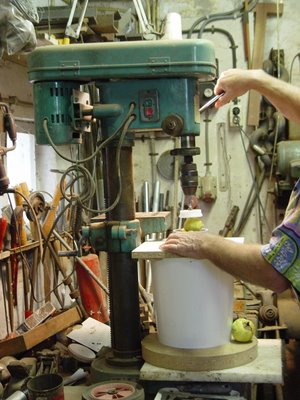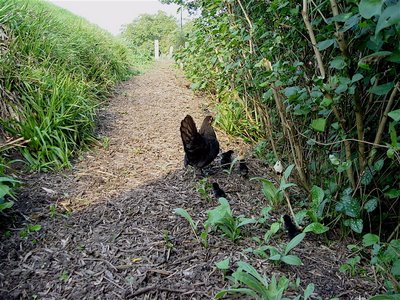Onze Kweepeerboom hing nog nooit zo vol als dit jaar, ook de maat van de vruchten is groter dan ooit. Ik denk dat ik er ruim 20 kg van af haalde. Tot overmaat van ramp kwam ook de buurman weer met een kist vol Kwee appels, helaas niet allemaal even rijp. Toch gebruik ik de meeste, net als vorig jaar wel. Vandaag ben ik dus weer begonnen aan het proces dat moet leiden tot een overheerlijke wijn. Vorig jaar was het eindresultaat een veel te zoete siroop, die ik gebruikte om de te zure Appelwijn op smaak te brengen. Het recept dat ik gebruik komt uit mijn 'wijnbijbel' van C.J.J.Berry vertaald uit het engels, het heet: Zelf Wijn Maken.
Our quince tree has never been as full of fruit as it was this year, and the fruit is larger than ever too. I think I got about 20 kilos off it. To make things even worse, a neighbour came along with a big box full of 'quince apples' quite a lot of which unfortunately were rather green. Still, I am using most of them, just as I did last year. So today I started on the whole process that should eventually lead to a delicious homemade wine. Last year the result was an oversweet syrup, which I used to even out the sourness of the (too sour) apple wine. I have taken the recipe from my 'wine bible' by C.J.J. Berry, titled First Steps in Winemaking.

Het is verstandig, hoewel het niet in het recept staat,het fruit eerst te wassen om eventuele spinnen, spinrag en andere ongeregeldheden kwijt te raken. Ook blad en steeltjes mogen er af.
Although no mention is made of this in the recipe, it's a good idea to wash the fruit first, to get rid of any spiders, spider webs, insects or other 'irregularities'. Leaves and stalks should be removed too.

Voor het splitten van de appels gebruikte ik een handig instrument, toen al dacht ik dat ik dat proces moest mechaniseren, vandaag heb ik dat gedaan. Ook nu weer bracht mijn ruim 35 jaar oude kolomboormachine uitkomst. Op de draaibank maakte ik een 'stempel' van nylon (oude vleessnijplaat van DUMECO), het witte ronde plaatje. Het handige snijdertje op z'n kop op een plaat met gat, emmer eronder en klaar is Kees. Het nadeel is dat dat splittertje niet voor zo'n hoge druk gemaakt is, het begint nu al al beetje hol te staan. Niet zo vreemd want kweeën zijn veel harder dan appels. Daar moet ik een ander mes voor maken.
To split the apples I bought a handy instrument. Then I thought that I should mechanise the process, which is what I did today. Once again, my more than 35 year-old drill press proved its worth. Using the lathe, I made a 'stamper', cut from nylon sheeting (an old meat-cutting board of DUMECO). That's the round white pressing slab you can see several pictures further down. I fixed the handy slicer upside down on a board with a hole cut out of it, placed the lot over a bucket, and off we go. The only disadvantage is that the slicer isn't designed to take a lot of pressure, so it's now starting to cave in. That's not so surprising, because quinces are a lot harder than apples, so now I'll have to make a new cutter.


Al met al heb ik drie emmers a 5 kg gesplit, daarna in de keukenmachine geraspt en in twee pannen gekookt. Dat zijn drie kookrondes a 15 min. Tussendoor naar de Super om suiker in te slaan en bij de buurman kijken naar de druiven. Die brengt hij woensdag, wit en blauw.

Na het koken gaat de inhoud van de pannen via een zeefdoek / perszak in een 20 liter emmer, op de suiker en citroen zoals in het recept staat. De perszak hang ik op boven de emmer en laat die lekker uitdruipen. Na drie keer koken heb je drie zakken met residu, die gaan bij elkaar in één zak en in de fruitpers. Ook dat levert weer ruim 2 liter sap op.
Altogether, I cut up three bucketfuls of 5 kilos each of quinces, grated them up in the food processor and then boiled each lot up in two big saucepans. That makes three lots of boiling up, taking 15 minutes each. In between I took off to the supermarket for extra sugar and then took a look at the neighbour's grapes, both black and white. He's going tp bring them along on Wednesday.

Na het koken gaat de inhoud van de pannen via een zeefdoek / perszak in een 20 liter emmer, op de suiker en citroen zoals in het recept staat. De perszak hang ik op boven de emmer en laat die lekker uitdruipen. Na drie keer koken heb je drie zakken met residu, die gaan bij elkaar in één zak en in de fruitpers. Ook dat levert weer ruim 2 liter sap op.
After cooking, according to the recipe the contents of the pans are strained through a muslin cloth/straining bag into a 20 litre bucket onto the sugar and lemon (both juice and rind). I hang the bag up on a hook over the bucket and leave it to drip. After three lots of cooking up you're left with three lots of residue, which are all put together into one big bag and then put into the fruit press. That yields, at the very least, a further two litres of juice.

Voor de nacht gaat er een kaasdoek over de emmer met bijna 20 liter sap, want de grootste vijand van de wijnmaker zijn de fruitvliegjes die nu al in grote getale rondzwermen. Morgen gaat er de gist bij en mag het een paar dagen blijven staan.
At night a muslin cheesecloth is draped over the bucket, now containing almost 20 litres of juice, because the biggest enemy of the winemaker is the fruit fly, which are already swarming around in large numbers. Tomorrow, yeast will be added and the mixture left to stand for a few days.


























